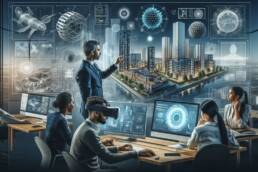The advent of 3D visualization technologies has brought about a transformative shift in product development, enabling designers, engineers, and marketers to visualize and refine products with unprecedented detail and realism. Through the use of sophisticated 3D modeling, rendering, and animation, the entire lifecycle of a product, from conception to marketing, is being reshaped. This article explores the multifaceted impact of 3D visualization on product development and how it stands to revolutionize the industry in the years to come.
Key Takeaways
- 3D visualization accelerates the product design process by allowing for rapid prototyping, iterative refinement, and enhanced collaboration between teams.
- High-quality 3D renders are not only tools for design but also powerful marketing assets that can elevate brand presence and provide interactive customer experiences.
- Cutting-edge 3D animation techniques enable dynamic product presentations and storytelling, essential for demonstrating product functionality and engaging potential customers.
- The integration of 3D product rendering in e-commerce, including virtual showrooms and augmented reality, is setting new standards for online shopping experiences.
- Advancements in 3D modeling technology are driving cross-industry applications, from virtual reality to data analytics, shaping the future of digital interaction and commerce.
Revolutionizing Product Design with 3D Visualization
From Concept to Prototype: The 3D Journey
In our journey from concept to prototype, we’ve witnessed a transformative shift in product development. The advent of 3D visualization has not only accelerated the design process but also enhanced the precision of our prototypes. High-fidelity visualization tools in NX CAD, for instance, allow engineers to create detailed and realistic digital prototypes, providing an accurate representation of the final product.
We’ve embraced a pipeline that begins with design, tech pack, and validation processes, all within the 3D realm. This approach ensures that by the time we move to 2D and manufacturing, we have a thoroughly vetted and validated design. The barriers in industries like footwear and leather goods are diminishing as more brands recognize the efficiency gains.
The ability to prototype and validate products faster and more accurately is a game-changer. It allows us to reduce time to market significantly by moving the engineering of the product back to the brand design level.
Our process is a testament to the power of 3D modeling in revolutionizing industries such as engineering and architecture. It enables us to create, test, and iterate designs in a more cost-effective and efficient manner. Here’s a glimpse into our process:
- Conceptualize the initial design in 3D
- Develop a tech pack with all necessary specifications
- Validate the design through digital prototyping
- Refine the prototype based on feedback
- Transition to 2D for manufacturing preparation
By integrating 3D visualization into our workflow, we’re not just designing products; we’re crafting experiences that begin long before the physical prototype is ever produced.
Enhancing Creativity and Precision in Product Development
We understand the transformative power of 3D visualization in product development. It’s not just about making things look good; it’s about enhancing the creative process while ensuring precision at every step. By leveraging advanced rendering technologies, we can explore design options with greater freedom and detail than ever before.
Collaboration is key in our industry, and 3D visualization tools have become indispensable for teams working together, whether they’re in the same room or across continents. Here’s how we’ve seen the process evolve:
- Conceptualization is now more dynamic, with real-time modifications and instant visual feedback.
- Design validation has become more efficient, reducing the need for physical prototypes.
- Communication with stakeholders is clearer, as 3D models convey ideas more effectively than 2D drawings.
We’ve witnessed firsthand how 3D visualization fosters a more iterative and exploratory approach to design. This not only saves time and resources but also empowers designers to push the boundaries of innovation.
With the support of partners like CG Viz Studio, we’re able to bring our visions to life with unparalleled accuracy and efficiency. Their commitment to revolutionizing product design with their services ensures that we stay at the forefront of our field.
The Impact of 3D Visualization on Design Iterations
We’ve witnessed a transformative shift in product development with the advent of 3D visualization. The iterative design process has become more dynamic and efficient, allowing for rapid prototyping and immediate feedback. Design iterations that once took weeks can now be visualized in days, significantly accelerating the time-to-market for new products.
- Rapid Prototyping: Quick conversion from concept to 3D model.
- Immediate Feedback: Real-time revisions and improvements.
- Enhanced Collaboration: Seamless sharing of 3D models among teams.
- Cost Reduction: Less physical prototyping needed.
By integrating 3D visualization into the design workflow, we enable a more collaborative and flexible approach to product development. This not only enhances the creative process but also reduces the risk of costly design errors.
The data supports this too; 3D visualization has a significant positive impact on online sales by improving customer engagement and confidence in their purchase decisions. As we continue to embrace these technologies, we can expect to see further advancements in how we create, refine, and market products.
The Strategic Advantage of 3D Rendering in Marketing
Elevating Brand Presence with High-Quality Renders
In our quest to elevate brand presence, we’ve embraced the transformative power of high-quality 3D renders. These visuals are not just images; they are a form of communication that conveys the essence of our products with stunning clarity and detail. It enables brands to create and refine prototypes digitally, offering a glimpse into the future of what we can offer our customers.
By harnessing the capabilities of 3D rendering, we’re able to present our products in the most favorable light, long before they physically exist. This preemptive showcase not only captivates potential buyers but also streamlines the feedback and approval process.
The benefits of high-quality renders extend beyond mere aesthetics. They serve as a cornerstone for marketing strategies, providing assets that can be repurposed across various channels. Here’s a quick rundown of the advantages:
- Cost Efficiency: Eliminates the need for physical prototypes and traditional photoshoots.
- Speed to Market: Accelerates the design and approval process.
- Consistency: Ensures brand and product representation remains uniform across all platforms.
- Engagement: Enhances customer interaction with lifelike and interactive visuals.
As we continue to explore the vast potential of 3D visualization, we remain committed to delivering experiences that resonate with our audience and solidify our position in the market.
Interactive and Immersive Customer Experiences
We’re witnessing a transformative era where interactive and immersive customer experiences are not just a luxury but a necessity for brands to stand out. By leveraging 3D visualization, we enable customers to engage with products in a virtual space, offering a tactile sense of ownership before the purchase. This deep level of interaction is revolutionizing the customer journey, providing a bridge between in-store and online shopping.
Our approach includes:
- Showcasing products in high detail with 360-degree views
- Enabling real-time product customization in 3D
- Utilizing Augmented Reality to place products in real spaces
- Offering Virtual Try-On for a personalized e-commerce experience
The synergy of 3D visualization and interactive technology not only captivates customers but also significantly boosts conversion rates and sales. It’s a powerful tool that enriches the online shopping experience, making it more dynamic and engaging.
As we continue to innovate, we’re committed to delivering experiences that not only meet but exceed customer expectations. The future is bright, and we’re excited to be at the forefront, crafting immersive experiences that resonate with consumers and drive the industry forward.
Leveraging 3D Assets for Effective Advertising Campaigns
We’ve seen firsthand the transformative power of 3D assets in advertising. By creating detailed and realistic representations of products, we can craft campaigns that not only capture attention but also immerse the audience in a virtual experience. The significance of 3D modeling for brand owners cannot be overstated; it’s a cost-effective marketing strategy that allows for diverse applications without incurring additional costs.
The visuals generated from 3D simulations are pivotal in driving marketing and e-commerce. They enable marketing teams to showcase all variations of a collection, providing a photo-realistic version of product variations and eliminating the need for costly photo shoots.
Moreover, the use of 3D Asset Managers streamlines the process of creating, storing, and managing these assets, transforming 2D images into dynamic 3D visuals. This efficiency is crucial when we consider the rapid pace of e-commerce and the need to stay ahead of the competition with innovative marketing tools like 3D advertising.
Here are some ways we leverage 3D assets effectively:
- Customizable products in 3D in real-time
- Digital product showrooms with 3D models
- Immersive experiences in the metaverse
By integrating 3D assets into our advertising campaigns, we provide customers with an interactive and engaging experience that not only tells the story of our product but also enhances the overall brand presence.
Cutting-Edge Technologies in 3D Animation for Product Visualization
Bringing Products to Life with Dynamic Animations
We understand the power of animation in breathing life into static product images. By incorporating dynamic animations, we transform the way products are perceived, making them more engaging and easier to understand. Animation for Product Launches: Enhancing Brand Impact with dynamic visuals is not just a concept; it’s a reality that we bring to fruition for our clients.
- 3D Product Visualization: Showcasing every detail of the product in the highest quality
- Interactive Experiences: Allowing customers to engage with products through 360° views
- Augmented Reality: Placing products in customers’ real spaces
- Virtual Try-On: Enabling customers to try products virtually
By leveraging these techniques, we ensure that the products are not just seen but experienced. This immersive approach is crucial in today’s competitive market, where capturing customer attention is paramount.
The feedback from our clients speaks volumes about the effectiveness of our animations. They’ve seen increased customer interest and higher engagement rates, which ultimately lead to better conversion and sales figures. Our commitment to excellence in animation ensures that every product’s story is told in a visually compelling and memorable way.
Storytelling Through Technology: The Narrative Power of 3D
We understand the profound impact that 3D visualization has on storytelling within product development. By crafting detailed and dynamic visual narratives, we can convey not just the appearance, but the essence and functionality of a product. The narrative power of 3D technology captivates audiences, allowing them to fully grasp the innovation and value behind each design.
Through the use of 3D animation, we can simulate real-world interactions and showcase products in various scenarios. This immersive approach to storytelling is not only engaging but also informative, providing a comprehensive understanding of the product before it even reaches the market.
The seamless integration of 3D visualization into marketing strategies enhances product demos, user engagement, design iterations, and collaboration in product design.
Here are some ways we leverage 3D technology for storytelling:
- Showcasing every detail of the product in the highest quality
- Allowing customers to interact with products through 360° views
- Creating immersive experiences with augmented reality
- Enabling virtual try-on for e-commerce platforms
By embracing these techniques, we revolutionize the industry with interactive experiences and cost savings, while also fostering a deeper connection between the product and its potential users.
The Role of Animation in Demonstrating Product Functionality
We understand the power of animation in showcasing the functionality of products. Animations breathe life into static models, allowing potential customers to grasp the product’s use and features in a dynamic and engaging way. For instance, an animated explainer video can demonstrate how a product operates, its assembly process, or how it fits within a larger system.
Interactive animations go a step further, offering customers a hands-on experience. They can interact with the product virtually, exploring its components and features at their own pace. This not only enhances the user experience but also builds a deeper understanding and appreciation of the product.
Here’s how animations can transform the demonstration of product functionality:
- Visualizing complex mechanisms with clarity
- Simulating real-world use and scenarios
- Highlighting product features and benefits
By integrating animations into our product demonstrations, we provide a comprehensive view that static images simply cannot match. This approach not only informs but also entertains, making it a powerful tool in our marketing arsenal.
The Future of E-Commerce: 3D Product Rendering and Virtual Showrooms
Transforming Online Shopping with Photorealistic 3D Renderings
We are witnessing a paradigm shift in online shopping as photorealistic 3D renderings take center stage. These renderings provide customers with a detailed and lifelike view of products, enhancing their shopping experience to levels previously unattainable with traditional photography. The Ultimate E-Comm Guide to 3D Product Rendering by Zakeke emphasizes the power of 3D visuals in boosting engagement and sales.
The benefits of 3D product visualization are numerous:
- Showcasing every detail of the product in the highest quality
- Allowing customers to interact with products through 360-degree views
- Enabling augmented reality experiences to place products in real spaces
- Offering virtual try-on capabilities for a more confident purchase decision
- Making products customizable in real-time, providing a personalized shopping experience
By moving from simple product photos to high-quality three-dimensional models, retailers are not just following a trend—they are responding to consumer preferences. A study by Shopify reveals that conversion rates can increase by up to 250% on product pages featuring 3D models and AR technology.
As we continue to innovate, the integration of 3D visualization in e-commerce platforms is becoming more seamless. Customers can now explore products from every angle, zoom in on details, and visualize items in different environments. This level of detail and interactivity significantly enriches the shopping experience, helping customers make more informed decisions and reducing the likelihood of returns.
Customizable Products in Real-Time: A New E-Commerce Paradigm
We are witnessing a transformative era in e-commerce, where customization and interactivity are not just desired but expected. The advent of real-time 3D product configurators is redefining the online shopping experience. Customers can now personalize products to their liking, choosing colors, materials, and designs, all within a user-friendly interface that requires no special skills.
- 3D Product Visualization: Showcasing every detail in high quality
- Interactive Experience: Engaging customers with 360° views
- Augmented Reality: Placing products in real spaces
- Virtual Try-On: Allowing customers to try products virtually
- Real-Time Customization: Making products customizable in 3D
The seamless integration of these technologies not only enhances the user experience but also significantly impacts the bottom line. High-end 3D visualization services revolutionize marketing with interactive experiences, enhancing customer engagement, boosting sales conversions, and reducing return rates through realistic product representations.
As we embrace this new paradigm, we are not just selling products; we are offering a unique digital journey that begins with the first click and continues through to a tailored product, crafted by the customer themselves. This is the future of e-commerce, where every interaction is an opportunity to connect with customers on a deeper level.
Virtual Try-On and Augmented Reality: The Next Frontier in Online Retail
As we explore the evolving landscape of online retail, we’re witnessing a paradigm shift with the introduction of virtual try-on and augmented reality (AR). These technologies are not just the next frontier; they are the present, reshaping the way we interact with products online. Virtual try-on capabilities empower customers to visualize products on themselves, enhancing confidence in their purchasing decisions and reducing the likelihood of returns.
Augmented reality takes this a step further by providing immersive experiences that were once the domain of physical stores. Now, from the comfort of their own homes, consumers can engage with products in a way that is both interactive and informative. The benefits of AR in e-commerce are manifold, and we’re just scratching the surface of its potential.
- 3D & AR Viewer: Seamlessly share 3D models on any platform.
- Virtual Try-On: Combines AI with virtual testing for a perfect fit.
By integrating these technologies, businesses are not only enhancing the customer experience but also streamlining their operations, aligning production more closely with consumer demand.
The High-End 3D Visualization Services website is a testament to the transformative power of these technologies. It offers a comprehensive suite of services that focus on virtual and augmented reality, revolutionizing business-consumer interactions. With options ranging from careers to FAQs, and from pricing to packages, the platform is a one-stop-shop for immersive experiences using VR and AR.
Advancements in 3D Modeling and Its Cross-Industry Applications
Emerging Trends and Real-Time Rendering Techniques
As we delve into the future of product development, we’re witnessing a remarkable shift towards real-time rendering techniques. This innovation allows us to see changes instantaneously, adapting to different lighting conditions and environments with unprecedented speed and flexibility. The implications for design and prototyping are profound, as we can now iterate and refine our models with a level of agility that was previously unimaginable.
The integration of real-time rendering into our workflow is not just a trend; it’s a transformative approach that is reshaping the landscape of 3D visualization.
Another exciting development is the growing use of simulation technologies in 3D modeling. These technologies enable us to create more complex and realistic visual effects, especially in industries like film and video games. The market is abuzz with key players like NVIDIA Corporation, Chaos Group, and Luxion, who are at the forefront of this innovation, continually pushing the boundaries of what’s possible in 3D visualization.
Here’s a glimpse at how these advancements are being applied across various sectors:
- Construction & Real Estate: Enhanced commercial project visualization
- Energy & Utility: Improved planning and simulation
- Media & Entertainment: More engaging and interactive content
- Education: Advanced tools for learning and exploration
3D Modeling’s Role in Virtual Reality and the Metaverse
As we delve into the realms of virtual reality (VR) and the metaverse, the significance of 3D modeling becomes ever more apparent. Our ability to craft detailed and immersive environments hinges on the sophistication of 3D models. These models serve as the building blocks for the expansive and interactive worlds that users explore with VR headsets, allowing for an unparalleled sense of presence and interactivity.
In the metaverse, 3D modeling is not just about visual fidelity; it’s about creating spaces that are functional, navigable, and conducive to social interaction. Here’s how 3D modeling is shaping these virtual spaces:
- Designing Virtual Real Estate: Crafting detailed architectural spaces for users to inhabit or visit.
- Creating Virtual Goods: From fashion to furniture, 3D models represent the products that users can buy, sell, or trade.
- Enabling User Customization: Allowing users to personalize their avatars and spaces, fostering a sense of ownership and identity.
The convergence of 3D modeling with VR and the metaverse is not just a technological evolution; it’s a cultural one. We are witnessing the birth of new forms of expression, commerce, and community, all facilitated by the intricate art of 3D modeling.
As we continue to push the boundaries of what’s possible, we remain committed to harnessing the full potential of 3D modeling to create experiences that are not only visually stunning but also deeply engaging and interactive.
Data Analytics and Customized Digital Collections
We’ve seen a transformative shift in how data analytics enhance product development. The integration of 3D modeling with data analytics allows us to track and archive interactions between brands and buyers, providing a wealth of insights. These insights are pivotal in developing digital collections that are not only customized but also collaborative, ensuring that each product resonates with its intended audience.
The digital twin technology is at the forefront of this revolution, enabling the creation of personalized product options. By closely aligning the efforts of designers, marketing, and sales teams, we can swiftly adapt to market trends and foster brand loyalty through Special Make-Ups (SMUs).
Our commitment to leveraging data analytics is unwavering, as it empowers us to create digital collections that are both innovative and customer-centric.
Furthermore, the application of AI in e-commerce is not just a passing trend. It’s a robust tool that enhances product searches, tailors suggestions, and automates customer service, thereby revolutionizing customer engagement with 3D product visualization. To measure the impact on sales conversion, we meticulously track customer engagement metrics, analyze conversion rates, and evaluate the effectiveness of our strategies.
The realm of 3D modeling is constantly evolving, opening up a universe of possibilities across various industries. From architectural visualizations to immersive video game environments, the applications are as limitless as your imagination. At CG Viz Studio, we pride ourselves on being at the forefront of this technological revolution. Our high-end 3D visualization services are tailored to bring your unique visions to life with precision and flair. Don’t just take our word for it; explore our extensive portfolio and see the difference professional 3D services can make. Ready to transform your project? Visit our website and let’s create something extraordinary together!
Conclusion
As we look to the horizon of product development, it’s clear that 3D visualization is not just a trend, but a transformative force reshaping the industry. Companies like CG Viz Studio are at the forefront, offering a suite of services that bring ideas to life with stunning realism. From architectural renderings to interactive product demos, the ability to visualize products in three dimensions is revolutionizing design, manufacturing, and marketing. Clients’ glowing testimonials reflect the value of 3D visualization in enhancing communication, expediting development, and captivating audiences. With advancements in technology and growing demand across various sectors, the future of product development is vividly three-dimensional, promising more immersive and customizable experiences that will continue to change the game for designers, manufacturers, and consumers alike.
Frequently Asked Questions
What is 3D product visualization and how does it benefit product development?
3D product visualization is the process of creating digital models and renderings of products before they are physically manufactured. It benefits product development by providing a realistic preview of the design, allowing for adjustments and improvements, reducing the need for physical prototypes, and facilitating better communication among stakeholders.
How does CG Viz Studio contribute to the 3D visualization industry?
CG Viz Studio specializes in creating high-quality 3D images, renderings, and animations for product visualization. They work with clients globally to transform design specifications into realistic visual assets that aid in decision-making and marketing of products.
Can 3D rendering be used for marketing and advertising campaigns?
Yes, 3D rendering is a powerful tool for marketing and advertising. It allows for the creation of high-quality, photorealistic images and animations that can be used in various media to showcase products attractively and engagingly.
What industries can benefit from CG Viz Studio’s 3D visualization services?
Industries such as architecture, product design, automotive, aerospace, consumer goods, and more can benefit from CG Viz Studio’s services. Their 3D visualization expertise aids in design, prototyping, and marketing across these sectors.
How is 3D animation used in product visualization?
3D animation brings products to life by simulating how they function and are used in real life. This dynamic form of visualization is effective for demonstrations, storytelling, and showcasing the unique features and benefits of a product.
What is the future of e-commerce with the integration of 3D product rendering?
The future of e-commerce is set to become more immersive and interactive with the integration of 3D product rendering. Virtual showrooms, customizable products in real-time, and augmented reality experiences are expected to transform online shopping, providing customers with a more engaging and personalized shopping experience.



